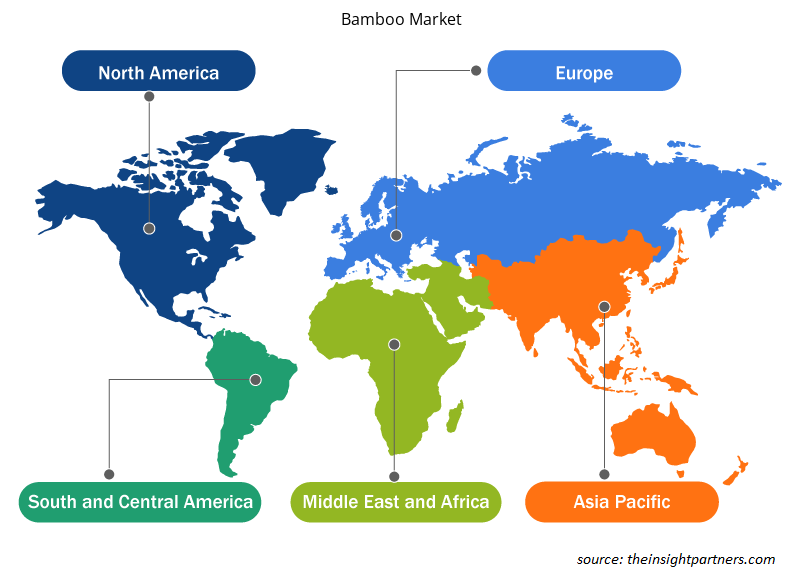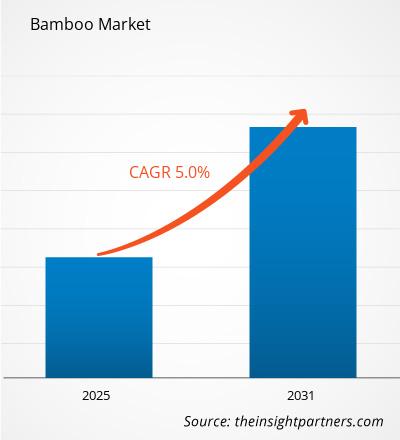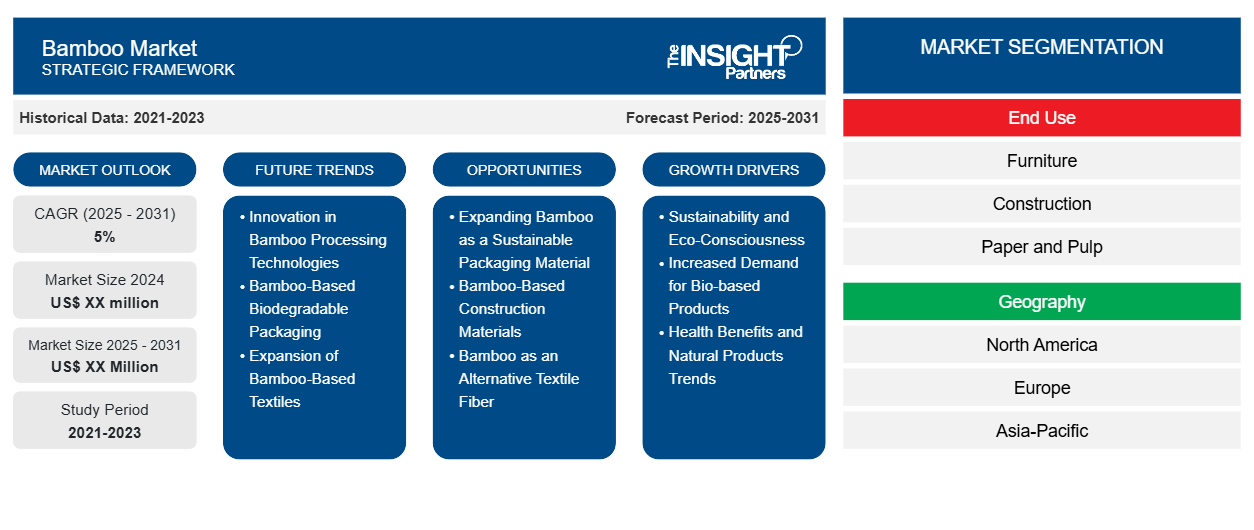Es wird erwartet, dass der Bambusmarkt von 2023 bis 2031 eine durchschnittliche jährliche Wachstumsrate (CAGR) von 5 % verzeichnet und dass die Marktgröße von XX Millionen US-Dollar im Jahr 2023 auf XX Millionen US-Dollar im Jahr 2031 wächst.
Der Bericht präsentiert Analysen basierend auf der Endnutzung (Möbel, Bauwesen, Papier und Zellstoff, Biomasse, Textilien und andere). Die globale Analyse ist weiter aufgeschlüsselt nach regionalen Ebenen und wichtigen Ländern. Die globale Analyse ist weiter aufgeschlüsselt nach regionalen Ebenen und wichtigen Ländern. Die Marktgröße und -prognose auf globaler, regionaler und Länderebene für alle wichtigen Marktsegmente werden im Rahmen des Berichts abgedeckt. Der Bericht bietet den Wert in USD für die oben genannte Analyse und die Segmente. Der Bericht bietet wichtige Statistiken zum Marktstatus der wichtigsten Marktteilnehmer und bietet Markttrends und -chancen.
Zweck des Berichts
Der Bericht Bamboo Market von The Insight Partners zielt darauf ab, die aktuelle Landschaft und das zukünftige Wachstum sowie die wichtigsten treibenden Faktoren, Herausforderungen und Chancen zu beschreiben. Dies wird verschiedenen Geschäftspartnern Einblicke geben, wie zum Beispiel:
- Technologieanbieter/-hersteller: Um die sich entwickelnde Marktdynamik zu verstehen und die potenziellen Wachstumschancen zu kennen, damit sie fundierte strategische Entscheidungen treffen können.
- Investoren: Durchführung einer umfassenden Trendanalyse hinsichtlich der Marktwachstumsrate, der finanziellen Marktprognosen und der Chancen entlang der Wertschöpfungskette.
- Regulierungsbehörden: Sie regulieren Richtlinien und polizeiliche Maßnahmen auf dem Markt mit dem Ziel, Missbrauch zu minimieren, das Vertrauen der Anleger zu bewahren und die Integrität und Stabilität des Marktes aufrechtzuerhalten.
Bambus-Marktsegmentierung
Endverwendung
- Möbel
- Konstruktion
- Papier und Zellstoff
- Biomasse
- Textil
- Sonstiges
Passen Sie diesen Bericht Ihren Anforderungen an
Sie erhalten kostenlos individuelle Anpassungen an jedem Bericht, einschließlich Teilen dieses Berichts oder einer Analyse auf Länderebene, eines Excel-Datenpakets sowie tolle Angebote und Rabatte für Start-ups und Universitäten.
- Holen Sie sich die wichtigsten Markttrends aus diesem Bericht.Dieses KOSTENLOSE Beispiel umfasst eine Datenanalyse von Markttrends bis hin zu Schätzungen und Prognosen.
Wachstumstreiber auf dem Bambusmarkt
- Nachhaltigkeit und Umweltbewusstsein: Bambus gilt als umweltfreundliche Alternative zu herkömmlichen Materialien wie Holz, Kunststoff und Metall. Angesichts der wachsenden Besorgnis über Abholzung, Klimawandel und Plastikmüll ist Bambus aufgrund seiner erneuerbaren Natur eine attraktive Wahl in der Möbel-, Textil- und Bauindustrie. Die zunehmende Vorliebe der Verbraucher für nachhaltige Produkte treibt die Nachfrage nach Produkten auf Bambusbasis an.
- Erhöhte Nachfrage nach biobasierten Produkten: Da sich der globale Trend hin zu nachhaltigen und umweltfreundlichen Alternativen verstärkt, wird Bambus zunehmend als praktikable Lösung für Verpackungen, Textilien und andere Konsumgüter angesehen. Die Vielseitigkeit des Materials in Verbindung mit seiner minimalen Umweltbelastung treibt seine Verwendung in verschiedenen Sektoren voran, darunter biologisch abbaubare Verpackungen und Möbel.
- Gesundheitsvorteile und Trends bei Naturprodukten: Bambus erfreut sich aufgrund seiner hypoallergenen, antimikrobiellen und natürlich antibakteriellen Eigenschaften in gesundheitsbewussten Märkten zunehmender Beliebtheit. Dies hat dazu geführt, dass Bambus in Textilien, Körperpflegeprodukten und Wellnessartikeln wie Zahnbürsten und Bettwäsche auf Bambusbasis verwendet wird. Da Verbraucher gesundheitsorientierten Produkten zunehmend den Vorzug geben, steigt die Nachfrage nach Alternativen auf Bambusbasis.
Zukünftige Trends auf dem Bambusmarkt
- Innovationen in der Bambusverarbeitung: Die Entwicklung moderner Verarbeitungstechniken ermöglicht die Herstellung hochwertigerer Bambusprodukte, wie etwa stärkere und haltbarere Textilien, Bodenbeläge und Baumaterialien. Diese Innovationen dürften den Markt für Bambus in neuen Anwendungsbereichen wie Hochleistungsbaustoffen und umweltfreundlichen Verpackungen erweitern.
- Biologisch abbaubare Verpackungen auf Bambusbasis: Angesichts der wachsenden Besorgnis über die Umweltverschmutzung durch Plastik stellt sich Bambus als praktikable Alternative für biologisch abbaubare Verpackungslösungen heraus. Da immer mehr Unternehmen auf nachhaltige Verfahren umsteigen, wird erwartet, dass die Nachfrage nach Bambusverpackungen steigen wird, insbesondere im Lebensmittel- und Konsumgütersektor, was Bambus zu einem Schlüsselmaterial in der Kreislaufwirtschaft macht.
- Expansion von Textilien auf Bambusbasis: Bambus wird in der Textilindustrie aufgrund seiner Weichheit, Haltbarkeit und Nachhaltigkeit zunehmend verwendet. Der Markt für Stoffe auf Bambusbasis, wie Bambusviskose, wird voraussichtlich wachsen, da die Verbraucher umweltfreundlichere Kleidung und Heimtextilien verlangen. Dieser Trend wird durch das steigende Bewusstsein für nachhaltige Mode vorangetrieben.
Marktchancen für Bambus
- Bambus als nachhaltiges Verpackungsmaterial immer beliebter: Der globale Trend hin zu mehr Nachhaltigkeit bietet Bambus als Verpackungsmaterial große Chancen. Immer mehr Branchen suchen nach umweltfreundlichen Alternativen zu Kunststoff. Bambus wächst schnell und ist biologisch abbaubar. Das macht ihn zu einer attraktiven Wahl für Verpackungsmaterialien, insbesondere im Lebensmittel- und Getränkesektor.
- Baumaterialien auf Bambusbasis: Die Haltbarkeit und Stärke von Bambus machen ihn zu einem idealen Material für nachhaltiges Bauen. Der wachsende Fokus auf umweltfreundliche Baupraktiken und umweltbewusste Infrastrukturentwicklung bietet eine enorme Marktchance für Bambus im Bausektor, insbesondere in Schwellenmärkten, in denen die Nachfrage nach erschwinglichem, umweltfreundlichem Wohnraum steigt.
- Bambus als alternative Textilfaser: Mit dem zunehmenden Bewusstsein der Verbraucher für nachhaltige Mode wird Bambus zu einer bevorzugten Alternative zu herkömmlichen Textilien wie Baumwolle und synthetischen Fasern. Das Wachstum der nachhaltigen Modebewegung bietet die Möglichkeit, Bambusfasern in Bekleidung, Heimtextilien und anderen stoffbasierten Produkten zu verwenden, was die Marktexpansion vorantreibt.
Regionale Einblicke zum Bambusmarkt
Die regionalen Trends und Faktoren, die den Bambusmarkt im Prognosezeitraum beeinflussen, wurden von den Analysten von Insight Partners ausführlich erläutert. In diesem Abschnitt werden auch Bambusmarktsegmente und -geografie in Nordamerika, Europa, im asiatisch-pazifischen Raum, im Nahen Osten und Afrika sowie in Süd- und Mittelamerika erörtert.

- Erhalten Sie regionale Daten zum Bambusmarkt
Umfang des Bambusmarktberichts
| Berichtsattribut | Details |
|---|---|
| Marktgröße im Jahr 2023 | XX Millionen US-Dollar |
| Marktgröße bis 2031 | XX Millionen US-Dollar |
| Globale CAGR (2023 - 2031) | 5 % |
| Historische Daten | 2021-2022 |
| Prognosezeitraum | 2024–2031 |
| Abgedeckte Segmente | Nach Endverwendung
|
| Abgedeckte Regionen und Länder | Nordamerika
|
| Marktführer und wichtige Unternehmensprofile |
|
Dichte der Bambusmarktakteure: Die Auswirkungen auf die Geschäftsdynamik verstehen
Der Bambusmarkt wächst rasant, angetrieben durch die steigende Nachfrage der Endverbraucher aufgrund von Faktoren wie sich entwickelnden Verbraucherpräferenzen, technologischen Fortschritten und einem größeren Bewusstsein für die Vorteile des Produkts. Mit steigender Nachfrage erweitern Unternehmen ihr Angebot, entwickeln Innovationen, um die Bedürfnisse der Verbraucher zu erfüllen, und nutzen neue Trends, was das Marktwachstum weiter ankurbelt.
Die Marktteilnehmerdichte bezieht sich auf die Verteilung der Firmen oder Unternehmen, die in einem bestimmten Markt oder einer bestimmten Branche tätig sind. Sie gibt an, wie viele Wettbewerber (Marktteilnehmer) in einem bestimmten Marktraum im Verhältnis zu seiner Größe oder seinem gesamten Marktwert präsent sind.
Die wichtigsten auf dem Bambusmarkt tätigen Unternehmen sind:
- MOSO International BV
- Dassogroup
- Shanghai Tenbro Bambus Textile Co., Ltd.,
- Bamboo Villages GmbH
- Xiamen HBD Industrie und Handel Co., Ltd.
Haftungsausschluss : Die oben aufgeführten Unternehmen sind nicht in einer bestimmten Reihenfolge aufgeführt.

- Überblick über die wichtigsten Akteure auf dem Bambusmarkt
Wichtige Verkaufsargumente
- Umfassende Abdeckung: Der Bericht deckt die Analyse von Produkten, Dienstleistungen, Typen und Endbenutzern des Bambusmarktes umfassend ab und bietet einen ganzheitlichen Überblick.
- Expertenanalyse: Der Bericht basiert auf dem umfassenden Verständnis von Branchenexperten und Analysten.
- Aktuelle Informationen: Der Bericht stellt durch die Abdeckung aktueller Informationen und Datentrends Geschäftsrelevanz sicher.
- Anpassungsoptionen: Dieser Bericht kann angepasst werden, um spezifische Kundenanforderungen zu erfüllen und die Geschäftsstrategien optimal anzupassen.
Der Forschungsbericht zum Bambusmarkt kann daher dabei helfen, die Branchensituation und Wachstumsaussichten zu entschlüsseln und zu verstehen. Obwohl es einige berechtigte Bedenken geben kann, überwiegen die allgemeinen Vorteile dieses Berichts tendenziell die Nachteile.
- Historische Analyse (2 Jahre), Basisjahr, Prognose (7 Jahre) mit CAGR
- PEST- und SWOT-Analyse
- Marktgröße Wert/Volumen – Global, Regional, Land
- Branchen- und Wettbewerbslandschaft
- Excel-Datensatz
Aktuelle Berichte
Erfahrungsberichte
Grund zum Kauf
- Fundierte Entscheidungsfindung
- Marktdynamik verstehen
- Wettbewerbsanalyse
- Kundeneinblicke
- Marktprognosen
- Risikominimierung
- Strategische Planung
- Investitionsbegründung
- Identifizierung neuer Märkte
- Verbesserung von Marketingstrategien
- Steigerung der Betriebseffizienz
- Anpassung an regulatorische Trends





















 Kostenlose Probe anfordern für - Bambusmarkt
Kostenlose Probe anfordern für - Bambusmarkt